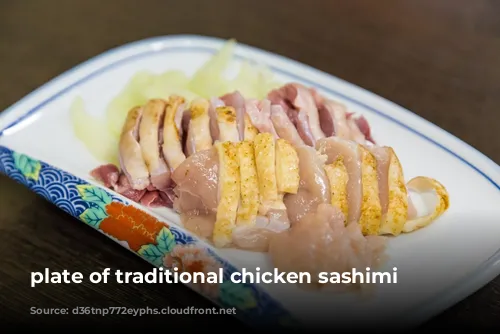Imagine this: you’re in a bustling Tokyo restaurant, surrounded by locals slurping noodles and downing beer. The menu boasts delicacies like fermented soybeans and cod sperm, but the most unexpected item is raw chicken. This isn’t some rogue culinary experiment, but a traditional Japanese dish called torisashi.
The Culture of Rawness
Japan has a unique relationship with raw food. It’s not just about daring; it’s a deep respect for the simplicity of ingredients. From sushi to nattō, the emphasis is on showcasing the natural flavors of the food, not obscuring them with complex preparations. Tokyo, the country’s culinary capital, embodies this philosophy in its diverse, vibrant food scene. The city’s energy is palpable, with countless restaurants offering an array of flavors and experiences.
Challenging the Salmonella Monster
As an American chef, the idea of raw chicken was terrifying. The “salmonella monster” lurked in my subconscious, a reminder of the dangers of undercooked poultry. But in Japan, where raw food is commonplace, I felt compelled to challenge my preconceptions. After all, wouldn’t it be a missed opportunity to ignore a dish that was so deeply embedded in the local culture?

The Science of Safety
The question of salmonella and campylobacter in raw chicken is a complex one. While the risk is real, high-end yakitori restaurants take meticulous steps to ensure safety. They source chicken from carefully selected farms, where the birds are slaughtered and butchered with utmost care to minimize contamination. The chicken breast, the muscle furthest from the intestinal tract, is considered the safest part for raw consumption.
A Delicious Experiment
My first torisashi experience was at Toriyoshi, a traditional yakitori joint tucked away in a bustling Tokyo neighborhood. The chicken was sliced thin, artfully arranged on a plate, and topped with ginger, shiso, and vinegar. The texture was surprisingly similar to raw tuna, with a delicate sweetness and a subtle chicken flavor. The vibrant atmosphere and the shared experience of enjoying a dish that many would consider risky helped to alleviate my initial apprehension.
The Art of Yakitori
Yakitori restaurants are famous for their skewers of grilled chicken, but torisashi is a lesser-known, yet equally important, part of the cuisine. At Toriki, a yakitori establishment renowned for its commitment to quality, the chef even slaughters his own chickens the morning before serving them. This dedication to freshness and meticulous preparation is key to ensuring the safety of raw chicken dishes.
A Culinary Adventure
While torisashi is a rare treat outside of Japan, there are a few places in the US where you can try it. But be cautious! Eating raw chicken at home or at unreputable restaurants is never a good idea. If you’re adventurous and find yourself in Tokyo, I encourage you to step outside your comfort zone and explore the world of torisashi. Just remember: freshness, cleanliness, and reputable establishments are paramount!
Where to Find Raw Chicken Sashimi in Tokyo
Toriyoshi: Located in the bustling Minato neighborhood, this traditional yakitori spot offers a true taste of Tokyo. The atmosphere is lively, and the chefs are skilled in preparing a variety of delicious dishes, including torisashi, grilled chicken skewers, and seasonal vegetables.
Toriki: Made famous by the late Anthony Bourdain, Toriki is a must-visit for any yakitori enthusiast. Their commitment to quality and freshness shines through in their toriwasa, a lightly seared chicken breast served with a touch of wasabi.
Birdland: This Michelin-starred yakitori restaurant is a true culinary gem. They offer a tasting menu featuring a variety of expertly prepared dishes, including torisashi. The high prices reflect the exceptional quality and experience.
Remember: While raw chicken can be a delicious and exciting culinary adventure, it’s important to be mindful of the risks. Always choose reputable establishments, and if you have any concerns, don’t hesitate to ask questions. Enjoy your culinary journey!

